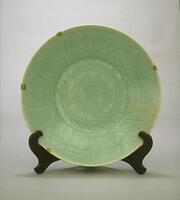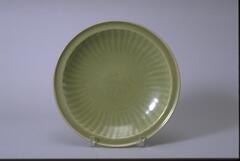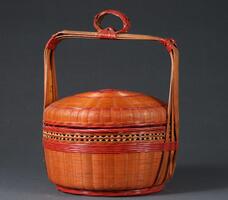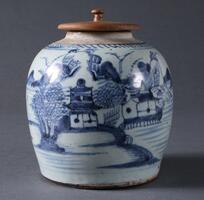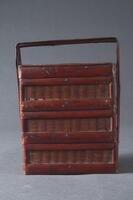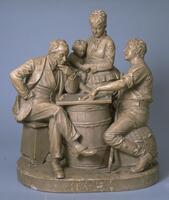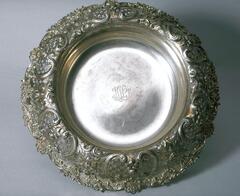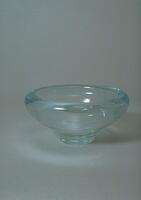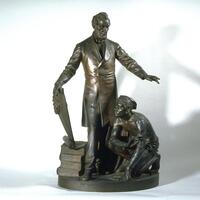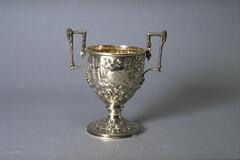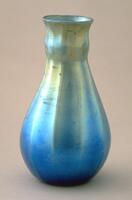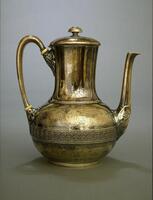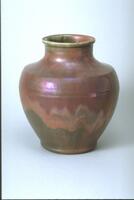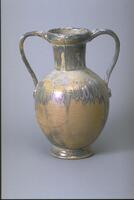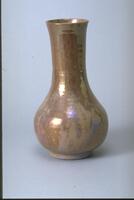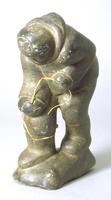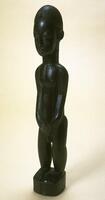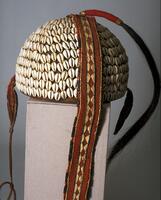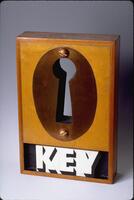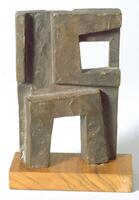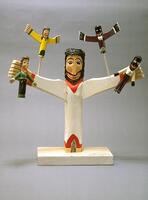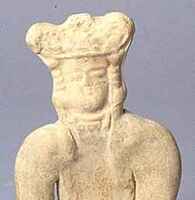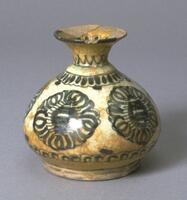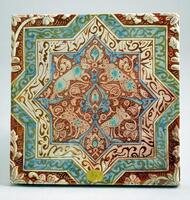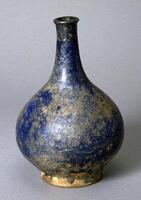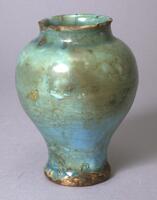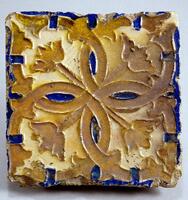Cabinet I: Shelf 3
Art of Islam
The millennium between the seventh and the seventeenth centuries marked the zenith of Islamic art and saw the creation of distinctive visual cultural forms as Islam was embraced by peoples of diverse ethno-linguistic backgrounds, ranging from Morocco and Spain on the Atlantic coast to Indonesia in Southeast Asia and from sub-Saharan Africa to Siberia.
In particular, during the rise of the Abbasid caliphate (749–1258) in a climate of political stability and prosperity, Islamic ceramics blossomed. Drawing on the influence of imported Chinese wares as well as local developments in metalware, craftsmen developed a wide range of techniques for making ceramics for both domestic use and architectural decoration. Many of the plates and vessels in the Museum’s collection are of a type called fritware. Invented in the twelfth century, fritware was an Islamic response to Chinese porcelain: by combining ground quartz with small amounts of white glaze, Middle Eastern potters were able to produce a thin-bodied, hard and durable white ware. Fritware provided an ideal surface for various painting techniques, including lustreware, underglaze painting, and overglaze enamels, all on display here (please see individual object descriptions). Also exhibited in this case is a selection of metalware. In the twelfth century, a new style of metalware emerged, where the surfaces of cast bronze objects were densely decorated in copper, gold, and silver inlays. Stunning examples of this can be seen in the two large candlesticks decorated with inscriptions and geometric patterns.
Created For
K-12 EducatorK-12 Student
Museum Visitor
UMMA Docent
UMMA Staff
University Faculty
University Student
Rate this Resource
AVG: 0 | Ratings: 0
& Author Notes
Creative Commons by-nc-saLast Updated
June 8, 2020 8:02 a.m.Report
Reporting Policy
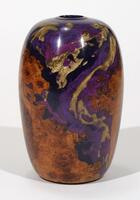
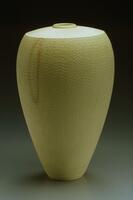
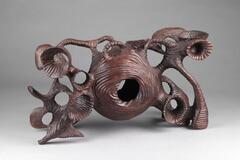

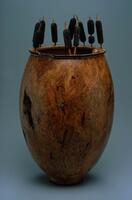

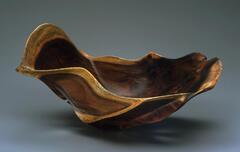
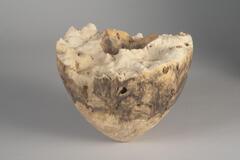

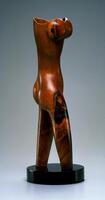

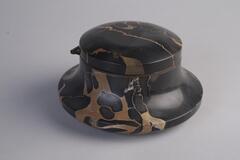

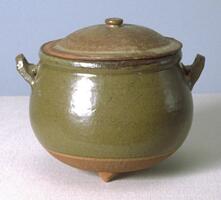
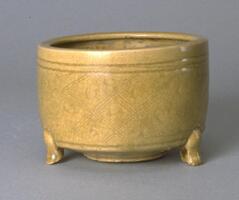
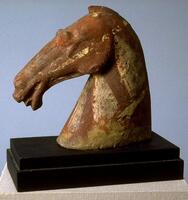


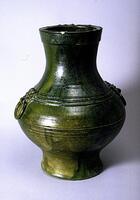
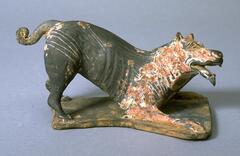
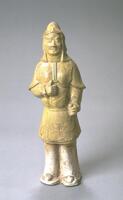

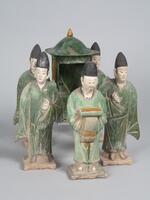
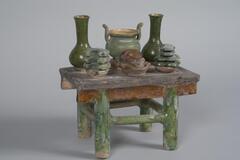

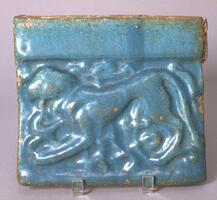
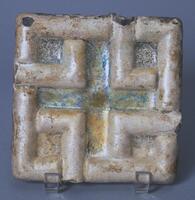
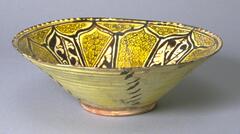
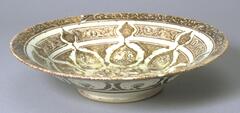
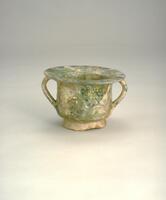
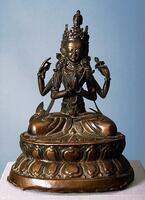

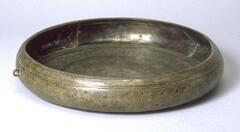
![This jar has a long and upright mouth with a robust shoulder that give way to a body tapering toward the base. The crane, cloud, pine tree and rock are painted with blue and red copper pigment.<br />
<br />
This jar was produced at a kiln in Bunwon-ri, Gwangju-si, Gyeonggi-do after the privatization of official court kilns in 1883. Ten longevity symbols, including pine trees, rocks, lingzhi fungus, deer, cranes, clouds and bamboo, are decorated in cobalt-blue and copper-oxide pigment was used in parts to decorate the jar. Such jars featuring the ten longevity symbols were often used at events such as elder statesmen’s gathering (giroyeon) and 60th birthday parties (hoegabyeon). Crackles were formed on the mouth and body, which are contaminated with impurities, but it remains intact overall. The foot retains traces of coarse sand supports, but lots of cracks were formed.<br />
[Korean Collection, University of Michigan Museum of Art (2014) p.169] This jar has a long and upright mouth with a robust shoulder that give way to a body tapering toward the base. The crane, cloud, pine tree and rock are painted with blue and red copper pigment.<br />
<br />
This jar was produced at a kiln in Bunwon-ri, Gwangju-si, Gyeonggi-do after the privatization of official court kilns in 1883. Ten longevity symbols, including pine trees, rocks, lingzhi fungus, deer, cranes, clouds and bamboo, are decorated in cobalt-blue and copper-oxide pigment was used in parts to decorate the jar. Such jars featuring the ten longevity symbols were often used at events such as elder statesmen’s gathering (giroyeon) and 60th birthday parties (hoegabyeon). Crackles were formed on the mouth and body, which are contaminated with impurities, but it remains intact overall. The foot retains traces of coarse sand supports, but lots of cracks were formed.<br />
[Korean Collection, University of Michigan Museum of Art (2014) p.169]](/media/W1siZiIsIjIwMjIvMDUvMjUvNjdqd3QzZzEybV9kZWZhdWx0LmpwZyJdLFsicCIsInRodW1iIiwiMjQweDIwMCJdXQ?sha=fecc2783f3328016)
![It has a long, thin neck and flat oval body. The wide foot is rather shallow but deeply recessed on the underside. The entire of surface is decorated with peony blossom design printed in cobalt blue sigment.<br />
<br />
This is a long-necked white porcelain bottle with peony sprays wrapping around the entire body. The white porcelain background is bright in colour, while the light and dark contrasts of the peony pattern give its flowers a three-dimensional appearance. There are sand spur marks on the foot, and on the outer base are incised symbols. Such marks are found in the waste deposits of kilns in Bunwonri, Gwangju-gun, Gyeonggi-do at the end of the 19th century. The mouth has been severed lost. This is a high-quality white porcelain bottle, with well sintered clay and glaze, but the rim has been severed and lost.<br />
[Korean Collection, University of Michigan Museum of Art (2014) p.179] It has a long, thin neck and flat oval body. The wide foot is rather shallow but deeply recessed on the underside. The entire of surface is decorated with peony blossom design printed in cobalt blue sigment.<br />
<br />
This is a long-necked white porcelain bottle with peony sprays wrapping around the entire body. The white porcelain background is bright in colour, while the light and dark contrasts of the peony pattern give its flowers a three-dimensional appearance. There are sand spur marks on the foot, and on the outer base are incised symbols. Such marks are found in the waste deposits of kilns in Bunwonri, Gwangju-gun, Gyeonggi-do at the end of the 19th century. The mouth has been severed lost. This is a high-quality white porcelain bottle, with well sintered clay and glaze, but the rim has been severed and lost.<br />
[Korean Collection, University of Michigan Museum of Art (2014) p.179]](/media/W1siZiIsIjIwMjIvMDUvMjUvNm53OGhsdGg5cl9kZWZhdWx0LmpwZyJdLFsicCIsInRodW1iIiwiMjQweDIwMCJdXQ?sha=b31b27d59eab8bb0)

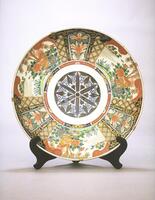
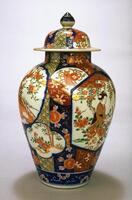

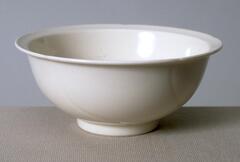

![<p>The inner base and walls of this celadon dish are mold-impressed with a peony and peony scrolls, respectively. The low foot retains traces of quartzite supports in three places. The glaze is poorly fused, showing traces of its running, while partial oxidization has given the dish a yellow-green hue in parts.<br />
[<em>Korean Collection, University of Michigan Museum of Art </em>(2014) p.114]</p>
The rim of this celadon saucer is outward flared. Fine crackles are present throughout the surface of the saucer, coated with a dark bluish green glaze. It has glazed short foot with 3 spur marks and is molded peony design on wall and bottom. The exterior glaze color change due to over heating, fired in sagger that was not tightly closed. <p>The inner base and walls of this celadon dish are mold-impressed with a peony and peony scrolls, respectively. The low foot retains traces of quartzite supports in three places. The glaze is poorly fused, showing traces of its running, while partial oxidization has given the dish a yellow-green hue in parts.<br />
[<em>Korean Collection, University of Michigan Museum of Art </em>(2014) p.114]</p>
The rim of this celadon saucer is outward flared. Fine crackles are present throughout the surface of the saucer, coated with a dark bluish green glaze. It has glazed short foot with 3 spur marks and is molded peony design on wall and bottom. The exterior glaze color change due to over heating, fired in sagger that was not tightly closed.](/media/W1siZiIsIjIwMjIvMDkvMjQvM2I3YWQ3MmZ2OF9kZWZhdWx0LmpwZyJdLFsicCIsInRodW1iIiwiMjQweDIwMCJdXQ?sha=43157896c18036d2)
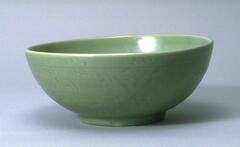
![<p>This vessel was produced in a form typical of 13th century celadon bottles with the beautifully curved form and inlaid decorations on the entire surface. The body is divided into six segments, each of which is inlaid with chrysanthemum stems rst then stamped with owers using the inhwa (stamping) technique. Glaze was wiped away from the base and sand supports were used during ring. Glaze on the lower part of the bottle was poorly fused, yielding an opaque surface, however the overall quality of sintering is fine. The mouth has been repaired and restored. This piece is assumed to have been produced at a kiln at Yucheon-ri, Buan-gun, Jeollabuk-do.<br />
[<em>Korean Collection, University of Michigan Museum of Art</em> (2014) p.136]</p>
<p>This vessel was produced in a form typical of 13th century celadon bottles with the beautifully curved form and inlaid decorations on the entire surface. The body is divided into six segments, each of which is inlaid with chrysanthemum stems rst then stamped with owers using the inhwa (stamping) technique. Glaze was wiped away from the base and sand supports were used during ring. Glaze on the lower part of the bottle was poorly fused, yielding an opaque surface, however the overall quality of sintering is fine. The mouth has been repaired and restored. This piece is assumed to have been produced at a kiln at Yucheon-ri, Buan-gun, Jeollabuk-do.<br />
[<em>Korean Collection, University of Michigan Museum of Art</em> (2014) p.136]</p>](/media/W1siZiIsIjIwMjIvMDkvMjQvOTlvajVlZGNtbl9kZWZhdWx0LmpwZyJdLFsicCIsInRodW1iIiwiMjQweDIwMCJdXQ?sha=15576c14322f15fc)
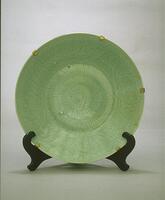
![<p>The long neck, curvilinear body, and ared mouth of this vessel create a typical Goryeo celadon bottle. A band of lotus petals inlaid with black and white slips is wrapped around the lower part of the neck, below which is a yeoui-head band inlaid with white slip. Three places around the belly of the bottle are decorated with lotus sprays inlaid with black and white slips. The glaze on the lower part of the body has been oxidized, where it is also extensively cracked. The foot is low, with a wide rim, and has sand spur marks.<br />
[Korean Collection, University of Michigan Museum of Art (2014) p.143]</p>
<p>The long neck, curvilinear body, and ared mouth of this vessel create a typical Goryeo celadon bottle. A band of lotus petals inlaid with black and white slips is wrapped around the lower part of the neck, below which is a yeoui-head band inlaid with white slip. Three places around the belly of the bottle are decorated with lotus sprays inlaid with black and white slips. The glaze on the lower part of the body has been oxidized, where it is also extensively cracked. The foot is low, with a wide rim, and has sand spur marks.<br />
[Korean Collection, University of Michigan Museum of Art (2014) p.143]</p>](/media/W1siZiIsIjIwMjIvMDkvMjQvMXFmdnRueTRuNl9kZWZhdWx0LmpwZyJdLFsicCIsInRodW1iIiwiMjQweDIwMCJdXQ?sha=0ca4162fd5e5e61f)
